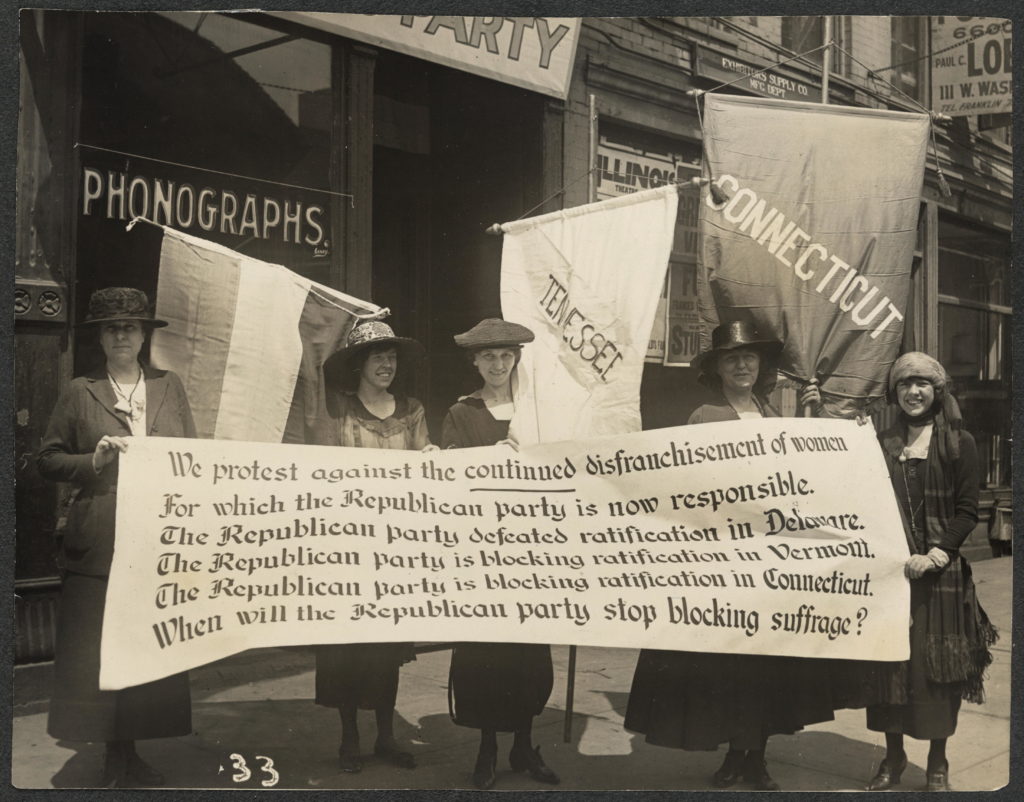
National Woman’s Party members, including Sue White of Tennessee (with banner) and Elsie Hill of Connecticut (with banner), picketing the Republican National Convention, Chicago, June 1920. photo: International Film Service Co., Library of Congress
By Elizabeth Normen
(c) Connecticut Explored Inc. Summer 2020
Subscribe/Buy the Issue!
In the critical months leading up to state-by-state ratification of the 19th Amendment to the U.S. Constitution granting women the right to vote, Connecticut’s state legislature was not in session. While the general assembly now meets annually (since 1970), alternating a long session (January to June in odd-numbered years) and a short session (February to May in even- numbered years), in 1920 it only met in the odd years. So when the U.S. Congress passed the 19th Amendment in June 1919, Connecticut’s general assembly was not scheduled to reconvene until January 1921.
By May 1920, of the nation’s 48 states, 35 had approved the amendment, 8 had rejected it, and 5 states—all eastern states from Vermont to Florida—could still act. Only one more was needed. Which one would put the amendment over the top?
Florida took no action (until 1969!). In the case of Vermont and Connecticut, a special session and the will of one man to call it—the governor—stood in the way of women’s suffrage. Vermont’s legislature had ratified the amendment in 1919, but Governor Percival Clement vetoed it and refused to call a special session to overturn his veto. Connecticut’s suffrage activists lobbied Governor Marcus Holcombe to call a special session, but he refused and would not budge. The previous September he had decided that taking action on the amendment was not the “special emergency” the state constitution required for a special session, even as he had acknowledged a “clear majority” of members of the general assembly supported both a special session and the amendment, The Norwich Bulletin reported on September 30, 1919.
But North Carolina and Tennessee did call special sessions, and on August 18, 1920 Tennessee ratified the amendment. Though it no longer mattered, North Carolina decisively voted it down the next day. With the November elections now looming and the inevitability of women’s voting weighing on the minds of many Connecticut legislators up for reelection, Gov. Holcombe (who was not seeking reelection) apparently had a change of heart about that “special emergency” required by the state constitution and called a special session on September 14. Perhaps seeking to appease and appeal to a swath of new voters, the Connecticut General Assembly passed the amendment.
The Connecticut State Library explains (page 54) Governor Holcomb’s thinking:
The 19th Amendment had been ratified by 35 of the required 36 states after the State of Washington voted in favor of it on March 22, 1920. Connecticut was on the list of “hopeful” states to be the 36th state to pass the amendment. But on August 26 Tennessee voted in favor by a margin of one vote. Under pressure from both pro- and anti-suffrage forces, Governor Marcus H. Holcomb called for a special session of the Connecticut General Assembly on September 14 only for the purpose of setting up the necessary legal mechanism for women to register to vote in the upcoming November presidential election. He was concerned about the validity of the 1920 presidential election if the proper procedures for women to register to vote were not in place. The general assembly, however, went beyond the session call and passed a bill ratifying the 19th Amendment. Out of fear of a court challenge to the legality of the general assembly’s action, Holcomb called for a second special session for the purpose of ratification. The legislature met on September 21 and ratified the bill twice more. Governor Marcus H. Holcomb’s files in the Connecticut State Archives are available on line through the state library’s namespace on the Connecticut Digital Archives at collections.ctdigitalarchive.org/islandora/object/30002%3ARG005-022_1919-1920.
Five women won seats in the Connecticut General Assembly that November. We’re covering one of them, Emily Sophie Brown, on page 41, and the rich history of Connecticut’s women’s suffrage in this, our commemoration issue, with special attention to women of color. Because we’ve covered women’s suffrage well in earlier issues, we’re also celebrating women and all of their accomplishments. For women’s suffrage stories in previous issues, visit ctexplored.org/100th-anniversary-of-womens-suffrage/.
We hope the arrival of summer finds us recovering from the COVID-19 pandemic of 2020 and that museums and historical societies are reopening and welcoming visitors. Please check their websites to confirm program and exhibition dates noted in Spotlight (starting on page 51) and throughout the issue.
During the unprecedented events of this spring, we were pleased to learn that school districts turned to our online educational resources as they moved quickly to teaching their students remotely. Visits to Where I Live: Connecticut surged. Where I Live is most heavily used by schools in the spring, and the free availability online of the 80-page e-book, 11 lesson plans, and 80+ pages of additional content enabled students to continue learning from home. The first of two webinars I presented in at the invitation of the State Department of Education, about our newest resource Venture Smith’s Colonial Connecticut, was enthusiastically received and at least three school districts planned to start using it right away.
Thank you again to all of CT Explored’s steadfast supporters. We anticipate experiencing repercussions for some time and hope those who can will continue to support us, the state’s nonprofit magazine and podcast of Connecticut history.
Explore!
Read all of our stories in the Summer 2020 issue
For women’s suffrage stories in previous issues, visit ctexplored.org/100th-anniversary-of-womens-suffrage/
